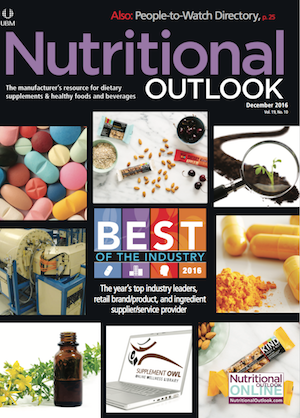2016 Dietary Supplement Mergers & Acquisitions' Driving Forces
Strong investment from China and private equity drove 2016’s health & wellness M&As.
Driven by all of the interest and innovation surrounding today’s nutritional, functional, and natural brands, the health & wellness (H&W) arena is “a very attractive space” for investors, says David T. Thibodeau, managing director, Wellvest Capital (Boston). With 120 M&As already on the books through Q2 of 2016, compared to 154 in 2015’s entirety, he sees the healthy-living segment as on track to top last year’s transaction total by year’s end.Â
“Will we get as high as 2014’s?” he asks. At 168, 2014’s transactions overall mark the peak of activity in the past half-decade. That depends on how markets respond to recent events-like this year’s U.S. presidential election. But no matter how investors interpret Decision 2016, “there are some strong valuations” buoying the health-and-wellness world, Thibodeau concludes. “So sellers have incentive to sell, and buyers that are able to pay premiums are able to buy.”
East Buys West
A growing number of those buyers now hail from China. Thibodeau isn’t alone in citing Chinese investors’ “voracious” appetite for North American, European, and even Australian H&W companies as an underlying motif of 2016’s investment activity. But that underlying motif somewhat upends a dominant theme of America’s recent election-namely, that domestic manufacturers are drowning on a floodtide of foreign (read: Chinese) imports.
“While many lament the unfavorable ChinaâU.S. trade deficit that the U.S. maintains by mainly importing goods,” the situation is reversed when it comes to dietary supplements. China has a strong demand for American-made supplements, says Scott Steinford, executive director/president, CoQ10 Association and Natural Algae Astaxanthin Association (Salt Lake City, UT). “Few products are as readily accepted by Chinese consumers as U.S.-made dietary supplements,” Steinford says. “So the impetus to invest in these products is higher.”
Also encouraging Chinese investment is the fact that the nation’s emerging affluence and aging population bode well for the category’s future success. Euromonitor reports that the Chinese dietary supplement market will increase 53% to $28.7 billion by 2021, Steinford notes; no wonder, then, that key players in 2016’s M&As include Chinese investors and American targets.
The Private Equity Stable
But they’re not alone. Another driving force behind this year’s H&W investment activity is the willingness of private equity groups to fatten up fledgling companies-and then unite them with eager buyers when they reach a respectable weight.
As Thibodeau explains, “The companies in our space are the innovation labs for many of the larger companies.” Absent a critical mass of financial support for their explorations, private equity steps in as the de facto capital supplier, shepherding the startups until they’re “a size that’s really attractive to the strategics.”
Some of those strategic investors are even forming investment vehicles of their own to nurture early-stage companies and “watch them more closely as they grow,” Thibodeau adds. “That’s how it’s working today, and that’s a much different model from it was 15 years ago.”Â
Ahead, Thibodeau and Steinford point to just a few examples of 2016 M&A deals that exemplify this changing model.
CLICK ON IMAGES TO VIEW SLIDESHOWPhoto © Shutterstock.com/Titov Nikolai

Prinova acquires Aplinova to further increase its footprint in Latin America
April 7th 2025Prinova has recently announced the acquisition of Brazilian ingredients distributor Aplinova, which is a provider of specialty ingredients for a range of market segments that include food, beverage, supplements, and personal care.






















